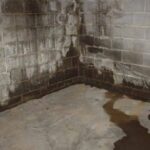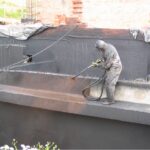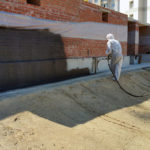Table of Contents
- Where can the water come from in the basement
- Consequences of water leaks in the basement
- What to do and how to fix the leak?
- Methods of eliminating leaks from the outside: A step-by-step plan
- Methods of eliminating leaks from the inside: Step-by-step plan
- General recommendation
Leaks in the basement are a fairly common case and many owners of private homes and commercial buildings face this problem, but not everyone understands the cause of such leaks, their consequences and how to deal with them. In this article, we will tell you in detail about the causes of problems with leaks and how to get rid of them yourself or with the help of a professional company.
Where can the water come from in the basement
A basement is a room that is located underground and, accordingly, is exposed to groundwater and surface water, which saturates the soil with moisture (rain, snow, etc.). The main reason for leaks in the basement is the lack of waterproofing on the outside of the basement walls and its foundation.
In the absence of waterproofing or its substandard installation, water is absorbed into the concrete, blocks and bricks from which the walls or foundation are made, and then gets inside the room through cold, interlocking and other seams, as well as through microcracks, capillary channels and pores in the base formed as a result of the impact of the same water on the basement walls from the outside.


Consequences of water leaks in the basement
Broken waterproofing or its absence can lead not only to leaks but also to more serious consequences associated with the destruction of the structure of concrete, bricks, and other materials, which in turn can threaten the reliability of the entire structure.
What causes leaks:
- Basement flooding – Water entering the basement can flood it, damaging the finishing elements, furniture, and electrical equipment;
- Cracks in the basement walls and foundation – When a leak occurs, water is absorbed into concrete or brick walls, through which it seeps into the room and freezes in the structure at a negative temperature. In spring, this water thaws expands, and destroys the bases, forming microcracks and pores, which eventually increase and turn from microcracks into a full-fledged problem;
- Mold and mildew – Leaks form a constant humidity of concrete, FBS blocks, or bricks, and thereby contribute to the formation of dampness, mold, and mildew that develop behind the finishing elements and threaten human health.





What to do and how to fix the leak?
Fixing a leak is not always easy and cheap, especially if you approach the problem thoroughly and solve its root, not the consequences. The root of such a problem is, as a rule, on the outside of a house or building and lies in the lack of high-quality waterproofing of walls or foundations from the outside.
Important: It is possible to eliminate the resulting leak from the inside the room or outside. When performing work outside, we restore the waterproofing of external elements of the house, protecting all elements of the house located below ground level from the effects of water and moisture. It is the external protection that solves the root of the problem with leaks inside the room.
Methods of eliminating leaks from the outside: A step-by-step plan
When performing work to eliminate the outside, it is necessary to get to the very base of the wall or foundation plate, which means that the following steps need to be taken:
- Dismantle the blind area;
- Dig up a building or a private house;
- Dismantle the insulation;
- Remove the old insulation;
- Clean the base from dust and dirt;
- Mount the fillet at the junction of the horizon and vertical (for a smooth transition installation);
- Apply a new reliable waterproofing to the foundation slab (if available) with a vertical base;
- Restore thermal insulation by fixing it with water-based cement glue;
- Install a spike-shaped membrane to protect the layers made, as well as for the installation of additional drainage;
- Perform backfilling;
- Mount the blind area.
When performing 6th stage, various protective systems can be used, such as:
- Liquid rubber
- Roll waterproofing
For additional protection of the house from leaks and groundwater, it is also recommended to install the following systems:
- Drainage system
- Storm sewer
- Blind area
Liquid rubber
Liquid rubber – is a unique material with properties such as high elasticity, water resistance, environmental friendliness, resistance to aggressive environments, and resistance to various temperature changes. In addition to the above, this material forms a reliable seamless coating with 100% adhesion to the base, which minimizes the possibility of leaks.
You can read more about this material in the article – “Waterproofing with liquid rubber”.





Roll waterproofing
Rolled materials can also be used to protect the basement from the outside. The main distinguishing factor of these materials is the presence of many seams and joints between the sheets, as well as the absence of 100% adhesion (adhesion) to the base. These distinctive features will also be the main disadvantages of rolled materials compared to rubber.
Types of roll insulation:
- PVC membranes – Mounted using pressure strips. The seams are sewn together with hot air.
- Surfaced bitumen rolls – are deposited using a burner with live fire.
You can read more about roll systems in the article – “ Arrangement of roll waterproofing”.





Drainage installation
In case of high groundwater or groundwater leakage into the basement, it is recommended to make a high-quality drainage system in addition to performing protection from the outside.
Drainage should be installed below the foundation level by 0.3-0.5 m, so that the drainage system made not only diverts water suitable to the house from the side, but also the groundwater that is under the house, thereby reducing the water pressure on the protection performed, which in turn will contribute to the absence of leaks in the future.
Important: Drainage is not waterproofing, it serves as an auxiliary system, thanks to which the insulation will last 5 times longer, since it will not be under constant water pressure.
You can read more about the drainage systems and methods of their installation in the article – “ The installation of drainage around the housing turnkey: Proper drainage, its types, installation technologies, materials, schemes, and prices“





Methods of eliminating leaks from the inside: Step-by-step plan
If it is impossible to eliminate the root of the problem, leaks can be stopped from inside the room. Methods of eliminating and combating leaks differ in the nature of leaks and where they manifest themselves. Detailed steps to eliminate and stop the formed water leaks in the basement are described below.
In cold, interlocking seams, cracks, and joints:
1. Pointing of seams or cracks by the method of a small indenting installation;
2. Layer-by-layer sealing of a high-quality expanding sealant into a made indenting;
3. Installation of packers along the perimeter of the seam or crack at a slope of 45 degrees (5 packers per 1 running meter.);
4. Injection of special injection compositions through pumping equipment;
5. Removal of installed packers and sealing of injection centers with a special sealant;
You can read more about the elimination of different leaks through the seams in the article – “ Sealing and waterproofing of concrete, cold and deformation seams”.
You can read more about the elimination of water flowing through cracks in the article – “Waterproofing and sealing of cracks in the concrete, brick, and other bases”.





In places where communications are entered into a house or building:
1. It is necessary to make a strobe around the sleeve or pipe and seal the expanding sealant there in layers;
2. Install a packer around the perimeter of the pipe and inject a polyurethane compound to fill all possible voids;
3. Dismantle the injectors and seal the holes with a special compound.
You can read more about stopping the flow of water through the entry points of cables and pipes into the basement in the article – “ Sealing and waterproofing of the inputs of communications into the building”.

In the body of the structure:
- Install packers (injectors) in a certain order;
- Inject into the body of the structure filling all the pores, voids and microcracks in the concrete or brick base;
- Remove the packer and seal the holes with a non-shrink sealant;
- Apply polymer cement waterproofing to the wall that can withstand negative water pressure.





Further, we will consider the above methods in more detail.
Injection waterproofing
A method in which, with the help of special pumping equipment and pressure, the necessary compounds are pumped inside the base and spread there into all possible pores, voids, capillaries and microcracks, thereby squeezing out existing moisture, eliminating possible leaks and making these areas waterproof.
You can read more about the method of injection in the article – “Injection waterproofing”.
Operation scheme of the injection method:

Penetrating waterproofing
Penetrating compounds are rarely able to stop active leaks alone, but they can help in terms of their future prevention. Penetrating materials are used mainly from inside the basement and after stopping the active leak, using various hydraulic seals and injection.
You can read more about penetrating materials and their properties in the article – “Penetrating waterproofing: The detailed description of its work on concrete, types of materials and technologies of application”.
Operation scheme of the penetrating insulation:

Polymer-cement waterproofing
As well as penetrating materials, cement polymers, despite the fact that some of them work on negative water pressure, are unable to stop its active flow alone. Before using cement insulation, it is recommended to perform injection, otherwise cement compositions may not withstand water pressure, which will cause leaks in the basement.
You can read more about cement waterproofing in the article – “Cement-based waterproofing: Features, types and methods of its application”.

General recommendation
A house is a significant and valuable investment. As such, you should always give him the best possible care. It is very important that you use the services of a professional company that can protect your basement, foundation, walls, roof, balcony, roof and other structures from leaks in the long term. Today, the problem is not to order waterproofing works in principle, but where to find and order professional and high-quality performance of these works, so that you do not have to redo everything later.
Pay attention: A large company always has an office where at least 10 people work, its own fleet, advertising brochures, business cars and other attributes of a serious company.









